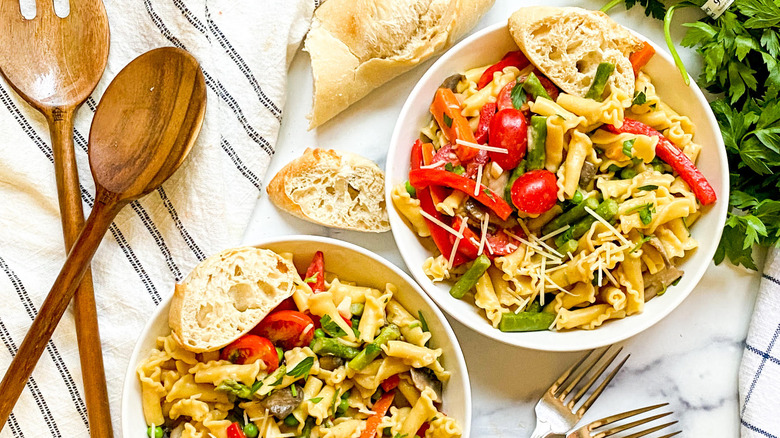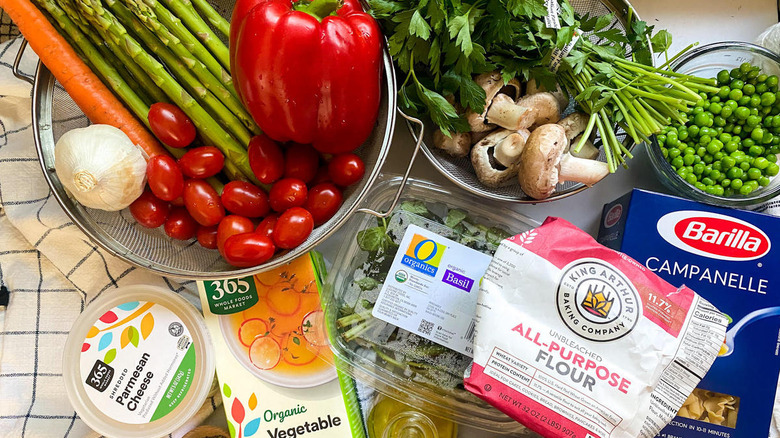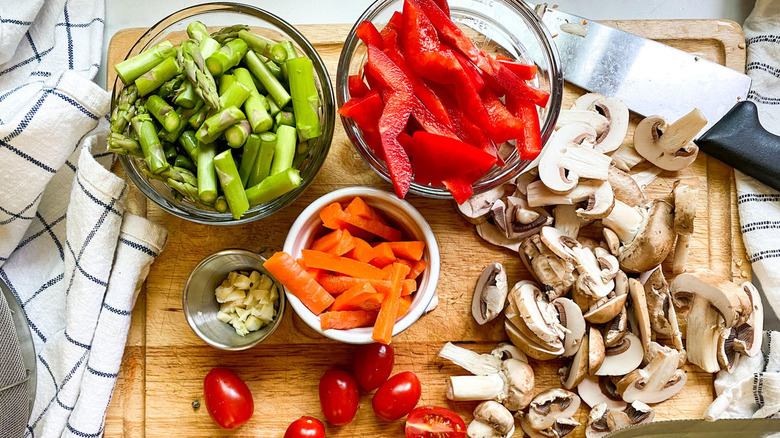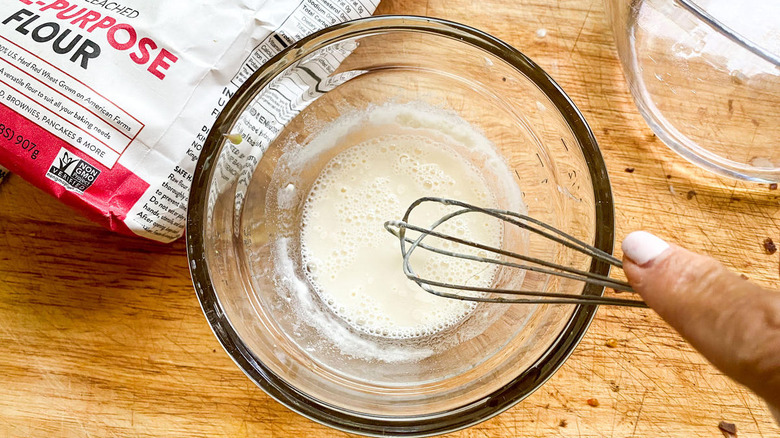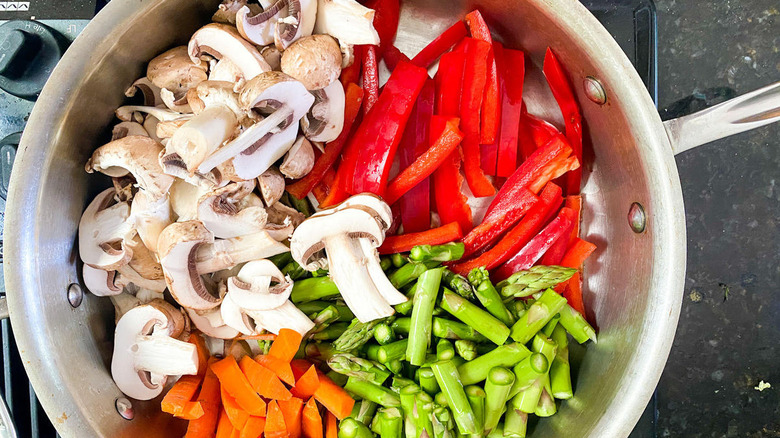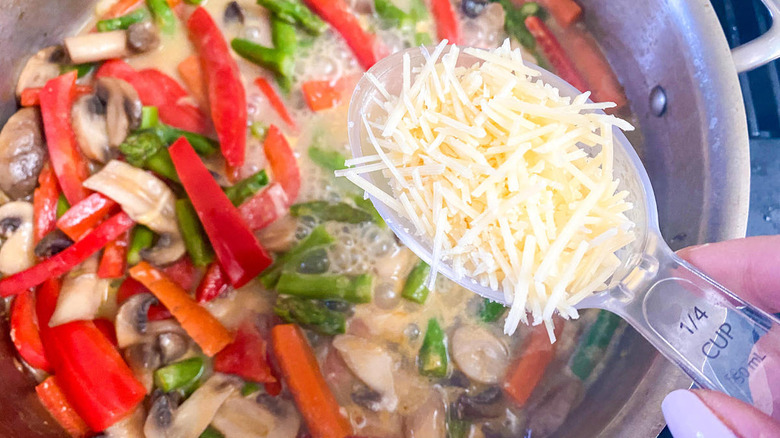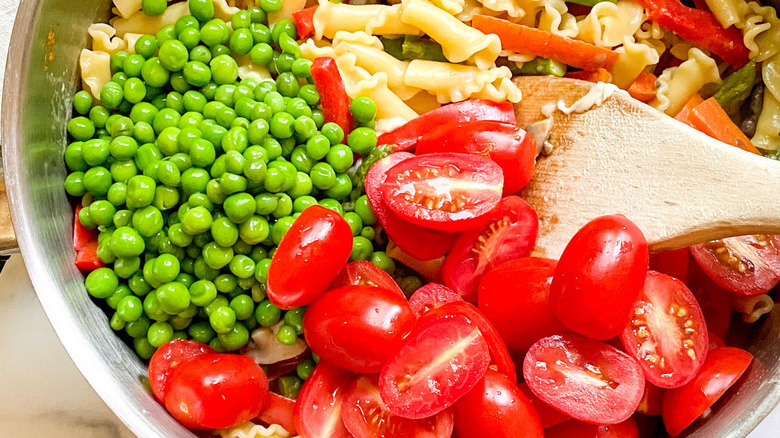Creamy Pasta Primavera Recipe
When we talk about recipes for "pasta primavera," there are many variations that we might be referring to, but two things you can count on all of them having in common are pasta and vegetables. For this creamy pasta primavera recipe — which you'll be happy to know is, in fact, "creamy," but contains no cream — wellness coach and recipe developer Miriam Hahn of YouCare-SelfCare decided to place a strong emphasis on the vegetables. Specifically, this recipe makes use of mushrooms, a red pepper, a carrot, asparagus, grape tomatoes, and peas.
Hahn's combination offers not only a variety of textures from soft to crunchy, but also a variety of flavors from umami to sweet to earthy. "[They] are lightly cooked and really complement each other," Hahn notes of the veggies she selected for this recipe. However, she invites you to make adjustments to her veggie choices based on your own preferences and what you have in the house.
Gather your ingredients to prepare this creamy pasta primavera recipe
As noted above, for this creamy pasta primavera recipe, you will need pasta and a whole bunch of vegetables. You'll also need a few other ingredients for flavor and the sauce's structure.
For the pasta, although what's pictured above is "campanelle" — aka pasta with ruffled edges — Hahn would like you to use whatever pasta shape you like best. Whatever you choose, you'll need 1 pound of it. For the veggies, you'll need an 8-ounce carton of mushrooms (which you can either slice or purchase pre-sliced), one carrot (peeled and sliced into bite-size pieces), one red pepper (sliced), one bunch of asparagus (trimmed and cut into bite-size pieces), 1 cup of halved grape tomatoes, 1 cup of frozen or freshly shelled peas, and two cloves of garlic (minced). You'll be cooking these in 1 tablespoon of oil.
For the sauce, you'll need to round up 1 tablespoon of flour, 3 tablespoons of water, 1 cup of chicken or vegetable broth, ½ cup of milk, 1 teaspoon of salt, ½ teaspoon of pepper, and ¼ cup of shredded Parmesan cheese. For the big finish, you'll need fresh basil and Italian parsley for sprinkling on top when serving.
Make sure the veggies are properly prepped
To the extent that you aren't able to find (or don't wish to purchase) your veggies pre-prepped, you'll want to prep your veggies so that they resemble the above photograph. As you can see, the red pepper is sliced, the carrot is julienned, the mushrooms are sliced medium-thin, and the garlic is minced. With regard to the asparagus, Hahn points out that it's important to break off the last few inches of the stem, because this part of the asparagus is tough. If you hold an asparagus spear, one end in each hand, and snap it, it will snap at just the right spot. Hahn also suggests using a serrated knife to cut the grape tomatoes, because this makes it much easier.
Create a flour mixture that will thicken up the sauce and give it structure
Now it's time to create a mixture of flour and water for the pasta primavera sauce. Simply whisk together the flour and the water in a small bowl, eliminating any noticeable lumps. The reason for this step is that the flour will lend structure and thickness to the sauce, and mixing it with the water beforehand ensures the sauce will have a much smoother texture.
Get the vegetables cooking
This is a great time to bring your pasta water to a boil. (And once it reaches a boil, cook according to the package instructions.)
While you're waiting for the pasta water to heat up, there should be adequate time to start cooking your veggies. For this, you'll need a deep frying pan. Put the oil into the pan, and heat over a medium-high flame. When it's sizzling hot, add the garlic, mushrooms, carrots, and asparagus, and cook for five minutes, stirring frequently to ensure even cooking and to avoid charring the garlic.
Combine the vegetables with the broth, milk, salt, and pepper, and bring the mixture to a boil
After five minutes have elapsed, add the broth, milk, salt, and pepper to the pan containing the vegetables. Stir together well, and bring the contents to a boil. Then, allow it to simmer for 10 minutes.
Meanwhile, when the timer for your pasta goes off, simply take the pot off the heat, empty its contents into a colander in the sink, and turn right back to whatever you were doing.
Mix the pasta with the veggies, serve with extra Parmesan cheese, and enjoy
After allowing the pasta water to drain off the pasta, there's no need to rinse the pasta. Simply transfer the drained pasta back to the pot in which it was cooked in, then add the vegetable mixture and Parmesan cheese, and stir. Finally, add the sliced grape tomatoes and peas to the pot. Serve immediately, topping with fresh basil, parsley, and more Parmesan cheese.
Creamy Pasta Primavera Recipe
This creamy pasta primavera recipe makes use of mushrooms, red peppers, carrots, asparagus, grape tomatoes, and peas for a healthy meal.
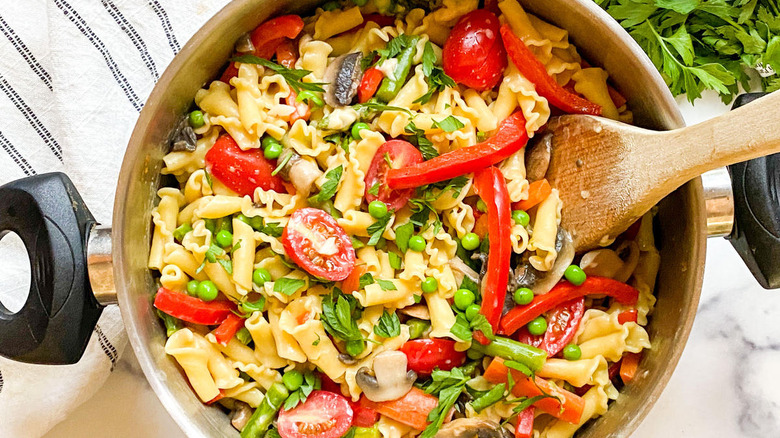
Ingredients
- 1 red pepper, sliced
- 1 carrot, julienned
- 1 bunch asparagus, trimmed to 1-inch pieces
- 1 (8-ounce) carton mushrooms, sliced
- 2 cloves garlic, minced
- 1 tablespoon flour
- 3 tablespoons water
- 1 pound pasta
- 1 tablespoon oil
- 1 cup chicken broth (or vegetable)
- ½ cup milk
- 1 teaspoon salt
- ½ teaspoon pepper
- ¼ cup Parmesan + more for topping
- 1 cup grape tomatoes, halved
- 1 cup peas, cooked
Optional Ingredients
- fresh basil, for serving
- Italian parsley, for serving
Directions
- Prep the red pepper, carrot, asparagus, mushrooms, and garlic.
- In a small bowl, whisk together the flour and water, and set aside.
- Bring the pasta water to a boil, and cook according to the package instructions.
- Heat the oil over medium-high heat in a deep frying pan. Add the garlic, red pepper, mushrooms, carrot, and asparagus. Cook for 5 minutes, stirring frequently.
- Add the flour mixture, broth, milk, salt, and pepper. Stir well. Bring to a boil, then simmer for 10 minutes.
- When the pasta is done cooking, drain it, then transfer it back into the pot you cooked it in.
- Add the vegetable mixture to the pot, along with the Parmesan cheese, and stir. Then, add the sliced grape tomatoes and peas, and stir to combine.
- Top with fresh basil, parsley, and more Parmesan before serving.
Nutrition
| Calories per Serving | 410 |
| Total Fat | 6.7 g |
| Saturated Fat | 2.0 g |
| Trans Fat | 0.0 g |
| Cholesterol | 7.4 mg |
| Total Carbohydrates | 70.0 g |
| Dietary Fiber | 6.0 g |
| Total Sugars | 8.7 g |
| Sodium | 557.0 mg |
| Protein | 17.8 g |
